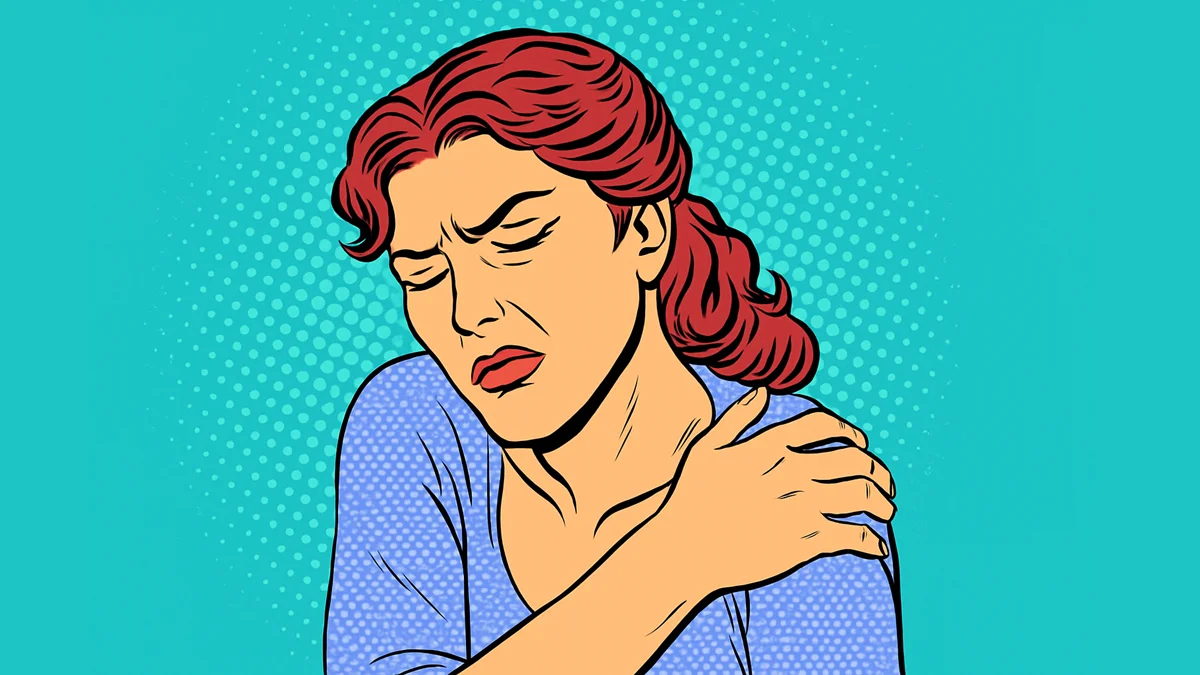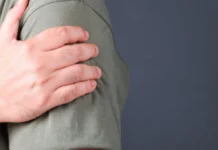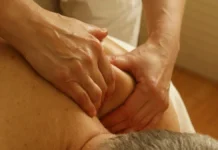Introduction
Proximal biceps tendon rupture is a relatively common injury that affects the tendon of the biceps brachii muscle, located in the upper arm. As an osteopath, a thorough understanding of this injury is crucial for an accurate assessment and optimal treatment plan, aimed at restoring muscle function and relieving pain.
This rupture of the proximal biceps tendon generally occurs in adults, often linked to a degenerative process of the tendon with age. Repetitive movements or sudden trauma can also contribute to this injury. Patients often report a tearing or popping sensation at the time of rupture, followed by sharp pain in the front of the arm. As an osteopath, I pay attention to these clinical presentations to guide my examination and develop an appropriate treatment plan.
Typical symptoms of a proximal biceps tendon rupture include muscle weakness, difficulty performing movements involving the arm, and a bump or protrusion in the upper arm, often described as a “bulge.” These clinical features guide my assessment, and I rely on osteopathic techniques to improve mobility and muscle function.
Treatment of proximal biceps tendon rupture depends on various factors, such as the severity of the injury, the patient’s activity level, and their functional goals. In some cases, a conservative approach, including physiotherapy and strengthening exercises, may be considered. As an osteopath, I integrate these approaches into a holistic framework, considering the overall impact of the injury on posture and mobility.
In more severe cases or when pain persists despite conservative interventions, surgery may be considered to repair the tendon. After surgery, rehabilitation becomes crucial to restore muscle strength and function to the arm. As an osteopath, I work closely with surgeons and physiotherapists to ensure a smooth transition to post-surgical rehabilitation.

Causes of proximal biceps tendon rupture
Rupture of the proximal biceps tendon, although less common than distal ruptures, is a condition that can have significant implications on arm function. Understanding the causes of this injury is crucial for healthcare professionals, such as osteopaths, to develop appropriate treatment plans and provide effective support to patients.
The main causes of rupture of the proximal biceps tendon are often linked to degenerative factors. With advancing age, tendons may undergo progressive degenerative changes, such as alterations in collagen composition and decreased vascularity. These changes make the tendon more vulnerable to injury, and rupture can occur during a sudden movement or excessive stress.
Repetitive movements, especially those involving flexion and rotation of the arm, can also contribute to rupture of the proximal biceps tendon. Professional or sporting activities that require intensive use of the arm can cause progressive wear of the tendon, thus increasing the risk of rupture. As an osteopath, I consider my patients’ daily habits and activities during the assessment to understand these potential risk factors.
Acute trauma is another cause of rupture of the proximal biceps tendon. A fall on the outstretched arm or a direct impact on the upper arm can cause a sudden tear of the tendon. Sports activities, especially those involving violent movements or heavy loads, can also be potential triggers. As an osteopath, I learn about my patients’ trauma history to assess the context of the injury.
Anatomical and pre-existing factors, such as abnormalities in tendon structure or underlying medical conditions, can also contribute to proximal biceps tendon rupture. For example, pre-existing calcifications or degenerative changes in the tendon can make the area more susceptible to injury. As a healthcare professional, I consider these factors to personalize my treatment approaches.
- Age: Proximal biceps tendon rupture is more common in older individuals, especially those over 60 years old. Aging causes degenerative changes in tendons, making them more susceptible to tearing.
- Progressive Wear: Repetitive arm movements, especially those involving work or sporting activities, can cause progressive wear of the proximal biceps tendon, increasing the risk of rupture.
- Acute trauma: Direct trauma to the shoulder, such as falls onto the outstretched arm or direct impacts, can cause an immediate tear of the proximal biceps tendon.
- Overuse: Excessive use or repetitive activities involving the arm can cause overuse of the biceps muscles, increasing the risk of tearing the proximal tendon.
- Incorrect movements: Inappropriate movements, especially during physical activities or sports, can place excessive pressure on the proximal biceps tendon, eventually leading to rupture.
- Genetic Factors: Some individuals may have a genetic predisposition to developing tendon problems, which can increase the risk of tearing the proximal biceps tendon.
- Decreased tissue quality: Factors such as smoking, poor diet and other lifestyle habits can contribute to decreased connective tissue quality, increasing the vulnerability of tendons.
Symptoms of proximal biceps tendon rupture
Proximal biceps tendon rupture presents distinctive symptoms that guide not only diagnosis but also planning of therapeutic interventions. As an osteopath, a thorough understanding of these symptoms is essential for an accurate assessment and implementation of a treatment plan tailored to the needs of each patient.
One of the most predominant symptoms of proximal biceps tendon rupture is sharp pain felt in the anterior portion of the arm. Patients often describe a tearing or tearing sensation at the time of injury, followed by persistent pain. As a practitioner, I take these descriptions into account to correlate with the history and refine the diagnosis.
Another characteristic sign of proximal biceps tendon rupture is muscle weakness, especially when flexing the elbow and rotating the forearm. Patients may have difficulty performing simple tasks that require strength in these movements, such as lifting objects or turning a key. The assessment of muscular strength guides my interventions, aiming to gradually restore the function of the biceps muscle.
A bump or protrusion in the upper part of the arm is often observable, corresponding to the folding of the biceps muscle not supported by the ruptured tendon. This deformation may be particularly evident during muscle contraction. My role as an osteopath is to take these anatomical changes into account when assessing joint mobility and function, adapting my techniques accordingly.
Stiffness and limitation of joint mobility are also symptoms associated with proximal biceps tendon rupture. Patients may experience discomfort when flexing or extending the elbow, and morning stiffness may also be present.
- Shoulder pain: Shoulder pain, especially in the anterior part, is one of the most common symptoms. The pain can be sudden and intense, often felt during the traumatic event that caused the breakup.
- Swelling: Swelling may occur in the shoulder area, in response to the injury and inflammation associated with the ruptured tendon.
- Hematoma: Rupture of the proximal biceps tendon can lead to the formation of a hematoma as a result of internal bleeding. This can cause bruising and discoloration of the skin.
- Muscle weakness: Loss of tendon integrity can lead to muscle weakness in the arm, especially during movements that involve the use of the biceps muscle.
- Distortion of the shape of the arm: In some cases, a deformation of the normal shape of the arm may be observed. This may be due to the tendon pulling out of its normal position.
- Difficulty flexing the elbow: Elbow flexion movements, such as those involving the biceps, may become difficult or painful.
- “Pop” sensation: Some individuals may feel or hear a “pop” sensation when breaking, especially during intense exertion or trauma.
- Decreased grip strength: The ability to grasp and hold objects may decrease due to loss of biceps tendon function.
- Persistent pain: Pain may persist after the rupture, especially when using the arm or during specific movements.
Pathophysiology of proximal biceps tendon rupture
- History of Shoulder Pain:
- Proximal biceps tendon ruptures most commonly occur in older adults who have a history of shoulder pain. This pain may be related to inflammation or tear of the rotator cuff, thereby predisposing the biceps tendon to further injury.
- Anatomical Position of the Tendon:
- The long biceps tendon passes in the intertubercular groove and is intra-articular over its proximal 3 cm. The shoulder capsule is in contact with the covering of the biceps tendon. Inflammatory changes in the shoulder can also affect the condition of the tendon.
- Predisposition to Attrition Lesions:
- Due to its anatomical position, the biceps tendon is predisposed to attrition injuries. Constant friction between the tendon and shoulder capsule can lead to progressive degenerative changes, increasing the risk of rupture.
- Common Events and Overuse:
- Rupture of the proximal biceps tendon is often preceded by a trivial event or overuse of the shoulder joint. Actions such as starting a lawn mower, performing a tennis overhead serve, or hitting golf balls excessively can trigger pain and functional disability.
- Acute Onset of Pain and Disability:
- Symptoms of rupture, such as pain and functional disability, usually manifest acutely. This occurs after episodes of overuse or misuse of the shoulder, causing the tendon to suddenly tear.
- Overuse or Misuse:
- Overuse of the shoulder joint, especially during activities involving overhead movements, can contribute to rupture of the proximal biceps tendon. Likewise, incorrect, forceful, or repetitive movements can put excessive pressure on the tendon.
- Influence of Inflammatory Changes:
- Inflammatory changes in the shoulder, such as those resulting from rotator cuff inflammation, may also influence the health of the proximal biceps tendon. Damage caused by inflammation can contribute to the progressive deterioration of the tendon.
Differential diagnoses of proximal biceps tendon rupture
- Rotator Cuff Tendonitis:
- Description: Inflammation of the rotator cuff tendons.
- Differentiation: Rotator cuff tendonitis has similar symptoms such as shoulder pain, but it involves inflammation rather than a tear of the tendon.
- Shoulder Bursitis:
- Description: Inflammation of the synovial bursa near the rotator cuff.
- Differentiation: Shoulder bursitis can cause similar pain, but it focuses on inflammation of the synovial bursa rather than tendon rupture.
- Carpal Tunnel Syndrome:
- Description: Compression of the median nerve at the wrist.
- Differentiation: Although related to the wrist, carpal tunnel syndrome can cause symptoms such as numbness and tingling in the arm, which can be confused with symptoms of a shoulder injury.
- Shoulder Osteoarthritis:
- Description: Progressive wear of the cartilage of the shoulder joint.
- Differentiation: Shoulder osteoarthritis can cause similar pain, but the underlying mechanisms and joint changes are different from a tendon rupture.
- Pinching of the Suprascapular Nerve:
- Description: Compression of the suprascapular nerve.
- Differentiation: A pinched suprascapular nerve can cause similar symptoms, but it is caused by nerve compression rather than a tendon tear.
- Adhesive Capsulitis (Frozen Shoulder):
- Description: Thickening and contraction of the joint capsule, limiting mobility.
- Differentiation: Adhesive capsulitis can cause symptoms of pain and mobility limitation, but the mechanisms and location of the symptoms are different.
- Injury of the Long Portion of the Biceps:
- Description: Injury to the long head of the biceps.
- Differentiation: An injury to the long head of the biceps may have similar symptoms, but it usually involves a different region of the biceps.
Diagnosis and treatment
Diagnosis and treatment of proximal biceps tendon rupture usually involves a multidisciplinary approach and can vary depending on the severity of the injury. Here is a detailed explanation:
Diagnostic :
- Physical examination :
- A thorough clinical examination is performed to evaluate the patient’s symptoms, shoulder mobility, muscle strength, and medical history.
- Medical imaging :
- Medical imaging, such as ultrasound or MRI, can be used to confirm the diagnosis, assess the extent of the rupture, and identify other possible injuries.
- Pain and Disability Assessment:
- Patients with a proximal biceps tendon rupture may undergo assessments of pain, muscle strength, and functional disability to determine the severity of the injury.
Treatment :
- Conservative Treatment:
- In cases of partial tears or in patients with less active requirements, conservative treatment may be recommended. This may include osteopathy, anti-inflammatory medications and activity modification to allow healing.
- Surgery :
- Surgery is often considered for complete ruptures or in active patients requiring maximum restoration of strength and function. Surgery may involve fixing the tendon in its original anatomical bed or anchoring it to another site.
- Post-Surgical Rehabilitation:
- After surgery, rehabilitation supervised by a physical therapist is usually recommended to restore muscle strength, mobility, and function of the shoulder.
- Pain Management:
- Analgesic and anti-inflammatory medications may be prescribed to manage pain, especially in the early stages of treatment.
- Regular Medical Follow-up:
- Regular medical monitoring is essential to assess the progress of healing, adjust the treatment plan if necessary and monitor the return to activities.
- Education and Prevention:
- Patients are often educated on preventative measures, including specific exercises to strengthen the rotator cuff and techniques to avoid overuse of the shoulder.
Exercises and stretching
After a proximal biceps tendon rupture, rehabilitation plays a crucial role in restoring shoulder strength, mobility, and function. Here are some exercises and stretches that can be included in a rehabilitation program, but it is important to consult a healthcare professional or physical therapist for personalized recommendations based on the patient’s individual situation.
Strengthening Exercises:
- Lateral Elevations:
- Hold a small weight in your hand and raise your arm out to the side until horizontal. Repeat controlling the movement.
- Rowing with Elastic Band:
- Attach an elastic band to a fixed point and pull it towards you while bending your elbow. Strengthen your back and shoulder muscles.
- Triceps work:
- Use light weights for triceps extensions, flexing and extending the elbow.
- Elbow Flexion with Elastic Band:
- Attach an elastic band to a fixed point and perform elbow bends to strengthen the biceps muscles.
Stretching:
- Triceps Stretch:
- Bend your arm behind your head and use your other hand to apply light pressure to your elbow, stretching your triceps.
- Deltoid Stretch:
- Place the opposite hand on your back and use the other hand to gently pull the fingers down, stretching the deltoid.
- Pectoral Stretch:
- Stand in a corner of a wall with your arm at 90 degrees, then gently twist your body to stretch your pectorals.
- Crossed Shoulder Stretch:
- Use the opposite arm to gently pull the affected arm in front of the body, stretching the shoulder muscles.
Important Notes:
- Exercises and stretches should be done slowly and with control to avoid excessive tension.
- Gradual progression is essential. Start with light loads and gradually increase.
- Listen to your body. If you experience abnormal pain, stop immediately and consult a healthcare professional.
- Post-operative rehabilitation often requires professional supervision.
It is crucial to personalize these exercises according to the specific needs of the patient, taking into account the severity of the rupture, overall physical condition and individual response to treatment.
Multiple Choice Questions on Rehabilitation after Rupture of the Proximal Biceps Tendon:
- What role does rehabilitation play after a proximal biceps tendon rupture?
- a) It has no impact
- b) It is crucial for restoring shoulder strength, mobility and function
- c) It is only necessary for professional athletes
- What strengthening exercise involves using a resistance band to work your back and shoulder muscles?
- a) Elbow flexion
- b) Lateral elevations
- c) Rowing with elastic band
- How to perform the triceps stretch?
- a) Raise your arm to the side
- b) Place the opposite hand on the back and gently pull the fingers down
- c) Bend your arm behind your head
- Why is it important to perform exercises slowly and with control?
- a) To finish more quickly
- b) To avoid excessive tension
- c) To impress the physiotherapist
- What exercise aims to strengthen the biceps muscles using an elastic band?
- a) Triceps work
- b) Rowing with elastic band
- c) Elbow flexion with elastic band
- Which stretch involves gently rotating the body to stretch the pecs?
- a) Pectoral stretch
- b) Crossed Shoulder Stretch
- c) Deltoid stretch
- Why is gradual progression essential during rehabilitation?
- a) To impress the physiotherapist
- b) To avoid any improvement
- c) To avoid excessive loads too quickly
- How to strengthen the biceps muscles in elbow flexion and extension?
- a) Rowing with elastic band
- b) Lateral elevations
- c) Triceps work with light weights
- Which exercise uses light weights to strengthen the triceps muscles?
- a) Elbow flexion with elastic band
- b) Lateral elevations
- c) Triceps work
- What is the main recommendation regarding supervision during post-operative rehabilitation?
- a) Not necessary
- b) Can be done alone at home
- c) Often requires professional supervision
Answers to Multiple Choice Questions on Rehabilitation after Rupture of the Proximal Biceps Tendon:
- b) It is crucial for restoring shoulder strength, mobility and function
- c) Rowing with elastic band
- c) Bend your arm behind your head
- b) To avoid excessive tension
- b) Rowing with elastic band
- a) Pectoral stretch
- c) To avoid excessive loads too quickly
- a) Rowing with elastic band
- c) Triceps work
- c) Often requires professional supervision






















